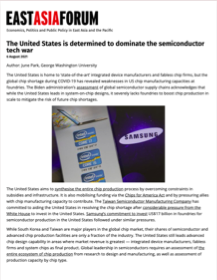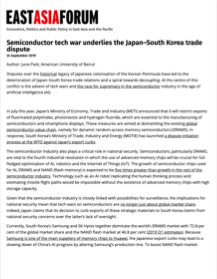 In May 2021, the East Asia Forum at Australian National University requested an update on the Japan-South Korean chip war which began in July 2019. I had been working on semiconductors for the past few years and was in the middle of preparing for my manuscript for peer-review in line with the latest developments. I learned through the contribution process once again that it is very difficult to blend historical issues and the chip war in a single piece. The piece carries the core arguments of my latest journal article manuscript that is under review.
In May 2021, the East Asia Forum at Australian National University requested an update on the Japan-South Korean chip war which began in July 2019. I had been working on semiconductors for the past few years and was in the middle of preparing for my manuscript for peer-review in line with the latest developments. I learned through the contribution process once again that it is very difficult to blend historical issues and the chip war in a single piece. The piece carries the core arguments of my latest journal article manuscript that is under review.
At the time of my initial contribution on the Japan-South Korea trade spat, the general view on the matter was heavily fixated on historical issues. The Huawei ban had just been put in place under Trump, and people did not see the clear linkage between the trade spat and the chip supply chain, but it was visible to the eye of this political economist. Two years on, we have a full-scale chip war ongoing in the midst of a pandemic that exacerbates it and accelerates the demand via the expansion of the digital economy while we’re social distancing.
 For readers that would like to see what went on in 2019, please refer to my EAF piece following the execution of Japan’s export curbs of semiconductor production materials against South Korea. This piece made the rounds back then and led to a full discussion on BBC Newshour a month later. Contrary to the beliefs of many, the export curbs stayed.
For readers that would like to see what went on in 2019, please refer to my EAF piece following the execution of Japan’s export curbs of semiconductor production materials against South Korea. This piece made the rounds back then and led to a full discussion on BBC Newshour a month later. Contrary to the beliefs of many, the export curbs stayed.
The full version of the peer-reviewed article that is currently under review will be presented at the Geoeconomics Working Group at the Australian National University on August 17, 2021. Unfortunately, the talk is closed to the public and I will not be able to post a video of it here on my research web or my BookTube. Will share more on the journal article when it gets to the publication stage.
